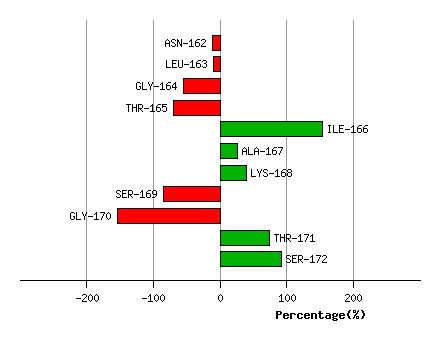Endoplasmin
(All numbering and residues are taken from first PDB file)
![]()
![]()
Bending Residue Dihedral Analysis
Residue
iResidue
i+1Distance of hinge axis to residue i in
(A) Distance of hinge axis to residue i in
(A) Change in
(deg) Change in
(deg) Angle of psi(i) axis to hinge axis
(deg) Angle of psi(i) axis to hinge axis
(deg) Percentage Progress
LYS-161
ASN-162
22.8
22.9
-4.3
4.0
55.6
54.7
-4.8
ASN-162
LEU-163
20.6
20.8
38.6
-28.5
77.3
78.1
2.6
LEU-163
GLY-164
20.2
19.8
17.9
-48.1
14.3
18.5
-45.7
GLY-164
THR-165
20.9
19.6
44.6
-75.7
61.9
68.2
-15.0
THR-165
ILE-166
18.1
18.1
-155.9
-24.4
68.2
42.5
223.3
ILE-166
ALA-167
15.7
16.1
59.9
26.3
74.6
108.0
-127.4
ALA-167
LYS-168
17.2
19.4
-6.3
19.2
167.8
19.8
14.1
LYS-168
SER-169
17.5
19.1
20.5
120.8
65.7
96.1
-124.4
SER-169
GLY-170
14.5
18.9
-139.9
-3.3
136.5
94.8
-69.7
GLY-170
THR-171
16.1
15.4
171.6
-11.8
47.2
66.6
229.0
THR-171
SER-172
14.5
13.6
17.6
3.5
80.9
45.7
17.6

Graph shows rotational transition at bending residues and can be used
to identify hinge bending residues.
Probably only informative for interdomain rotations greater than 20 degrees
Residue
iResidue
i+1Distance of hinge axis to residue i in
(A) Distance of hinge axis to residue i in
(A) Change in
(deg) Change in
(deg) Angle of psi(i) axis to hinge axis
(deg) Angle of psi(i) axis to hinge axis
(deg) Percentage Progress
GLY-193
GLN-194
4.4
8.2
-9.6
9.3
90.3
98.0
-6.3
GLN-194
PHE-195
6.3
8.4
-29.5
-13.0
97.2
57.7
26.2
PHE-195
GLY-196
9.3
10.8
21.9
166.8
17.4
93.3
204.6
GLY-196
VAL-197
9.0
12.4
22.1
26.5
51.6
147.5
-36.4
VAL-197
GLY-198
8.8
12.1
-124.1
-144.8
74.0
90.6
-10.2
GLY-198
PHE-199
11.9
11.9
160.4
6.0
103.8
107.7
-76.2
PHE-199
TYR-200
15.3
15.4
-2.8
-8.6
48.0
42.9
10.2
TYR-200
SER-201
14.1
14.4
7.8
-5.2
68.9
76.3
-5.5

Graph shows rotational transition at bending residues and can be used
to identify hinge bending residues.
Probably only informative for interdomain rotations greater than 20 degrees